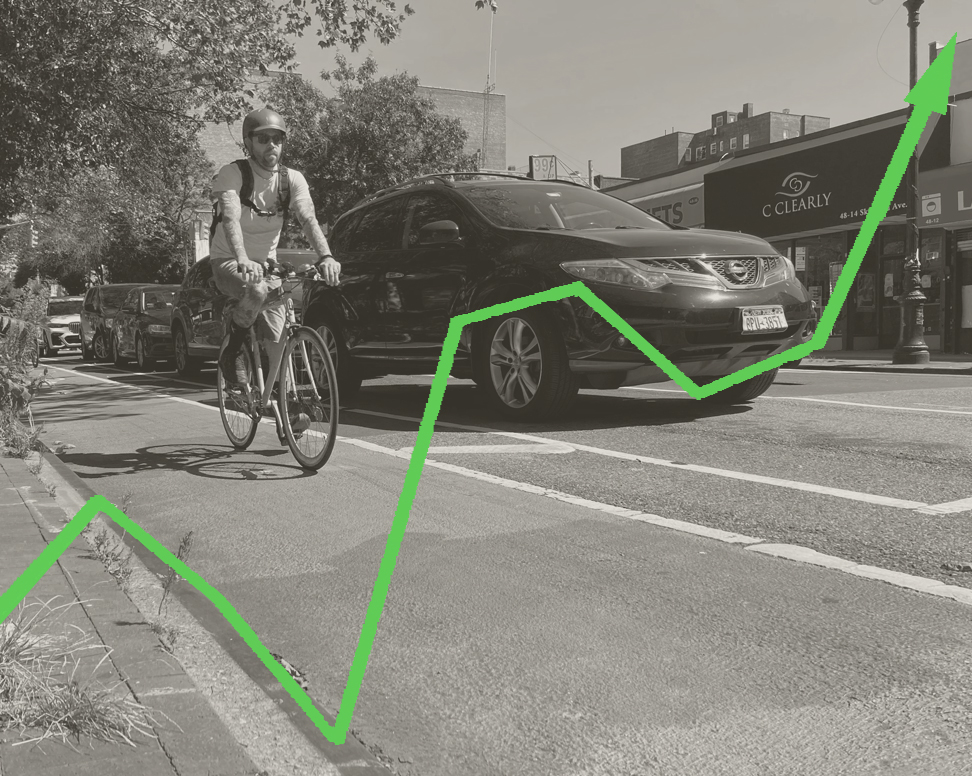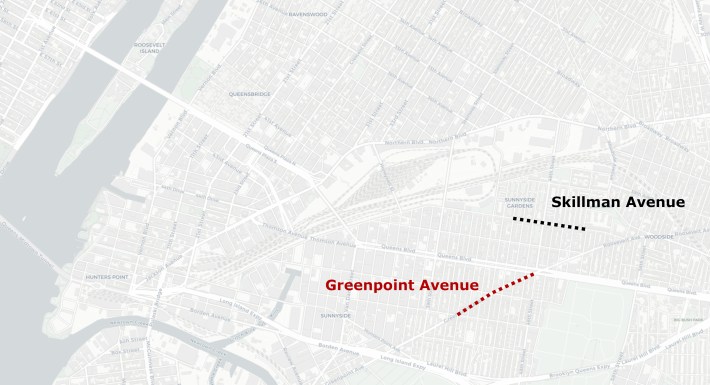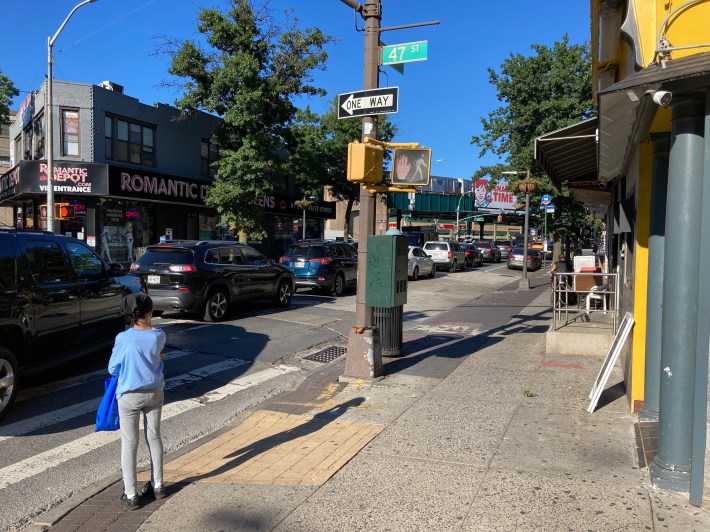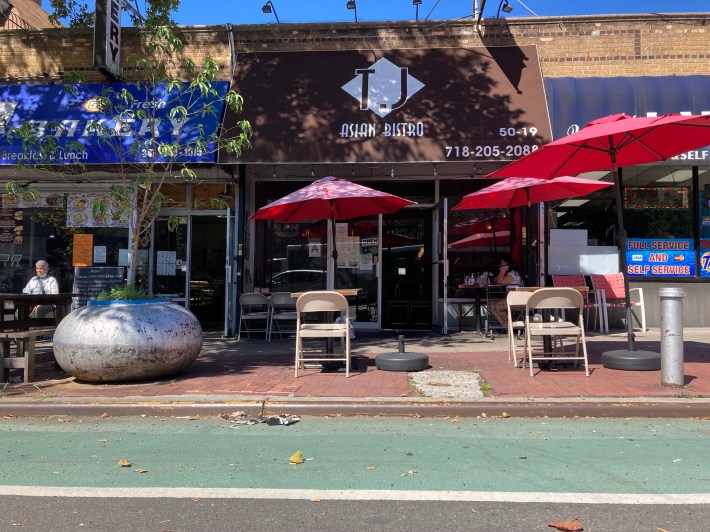Business Grew After Controversial Bike Lane Installed, Data Show
12:01 AM EDT on September 30, 2022

The Skillman Avenue bike lane in September 2022. Business has grown on the street since the city installed it four years ago. Photo: Jesse Coburn
When New York City proposed installing a protected bike lane on Skillman Avenue in Queens in 2017, the impact it would have on local businesses was certain — at least according to the plan’s critics.
A devastating loss of customers. Revenue falling by 20 percent. Beloved shops forced to close their doors for good.
Those predictions were wrong.
Data obtained by Streetsblog through a Freedom of Information request shows the economy of Skillman Avenue grew after the city built the new lane in the fall of 2018, with revenue increasing and new businesses setting up shop.
Sales in the stores, bars and restaurants on Skillman’s main seven-block commercial stretch collectively rose by 12 percent after the lane went in, according to the data, which was provided by the city Department of Finance. There was also a net increase of three new businesses on the strip, a jump of 10 percent.
Today the main drag of the western Queens neighborhood is as lively as ever, with restaurants, bars, bodegas, and other mom-and-pop establishments doing brisk business. Some locals credit the new bike lane.
“It definitely helps,” said Mark O’Dowd, the manager of the P.J. Horgan’s bar on Skillman. “People drop their bikes here, they pop in for a beer.”
Streetsblog’s findings align with a growing body of research — including an oft-cited but nearly decade-old study by the city Department of Transportation — showing that so-called active transportation infrastructure has a neutral or positive impact on local commerce. The data also challenge one of the most frequent arguments against new bike lanes — that they’ll hurt neighboring businesses — an argument that continues to surface in new disputes as the DOT endeavors to fulfill a legal requirement to build 30 miles of protected bike lanes each year.
For one opponent of the Skillman bike lane, Streetsblog’s findings prompted a reconsideration of once firmly held beliefs.
“You’ve got to go with what the data tells you,” said Brent O’Leary, a local community leader who once argued that the lane had been a “real burden” on small businesses.
“If it shows that that wasn’t the case then I wouldn’t fight it,” O’Leary said in an interview this month. “If there’s good data I will always change my position.”
The city first proposed building the Skillman Avenue bike lane — and another on parallel 43rd Avenue — in the fall of 2017 after drivers killed one cyclist and critically injured another in the area. The bloodshed sparked an outcry from safe streets advocates, the neighborhood’s then-Council Member Jimmy Van Bramer, and the family of Gelacio Reyes, the man who was killed. The DOT then developed a plan to redesign the streets with better sight lines at intersections, new pedestrian islands, reconfigured traffic lanes and, yes, protected bike lanes.
The backlash was extreme. Civic groups rallied against the proposal. Opponents packed community meetings that lasted hours. Van Bramer waffled on his position. A cyclist found thumb tacks scattered along four blocks of the new bike lane on 43rd Avenue.
Throughout the protracted dispute, opponents again and again made the same assertion: removing parking on Skillman to make way for street-safety features would hurt local merchants.
“They’re basically telling us they can’t continue doing business if they lose all that parking,” Denise Keehan-Smith, who chaired the local community board at the time, said in 2017.
“Protected bike lanes do not guarantee safer streets, but it will mean a loss of business,” Gary O’Neill, owner of the Aubergine Cafe on Skillman, said a few months later.
“Some of the stores have already said, at the end of August, they may not be able to last because the businesses have clients and cars,” said Pat Dorfman, the head of an anti-bike-lane group.
The dire economic assumptions even factored into then-Rep. Joe Crowley’s opposition to the plan.
“Adding these bike lanes would have far too great of an economic cost and impact on our neighborhood,” he wrote in a statement.
Four years later, those grim predictions have not come to pass. Streetsblog’s analysis revealed:
- In the spring of 2017, more than a year before the bike lane was installed, there were 31 retail or food service business that collectively made $3.11 million in taxable sales that quarter on Skillman Avenue between 45th and 52nd streets. By early 2020, there were 34 businesses that collectively made $3.47 million in the quarter.
- By some measures, Skillman outperformed its surroundings. Streetsblog also obtained sales tax data from the same period for Queens as a whole and for a nearby stretch of Greenpoint Avenue that is similar in character to Skillman Avenue but has no protected bike lane. While new businesses were opening on Skillman Avenue, they were closing on Greenpoint Avenue, which lost a net of two businesses over the same period. Queens also lost businesses.
- Skillman’s 12-percent increase in collective quarterly sales was greater than the increase in Queens as a whole (3 percent).
By other measures, Skillman performed worse than its surroundings. The increase in collective quarterly sales was even greater on Greenpoint Avenue (16 percent) than on Skillman (12 percent). And Greenpoint Avenue and Queens enjoyed larger increases in quarterly sales when measured on a per-business basis. Each business on Skillman saw on average a $1,700 (2 percent) quarterly increase in sales, while the increase was $6,600 (6 percent) per business in Queens as a whole and $19,400 (20 percent) per business on Greenpoint Avenue.

As for street safety, other city data shows the dangers on Skillman dropped dramatically on average for all road users after the bike lane was installed — much as DOT said it would. Crashes on the avenue fell by 24 percent — and injuries from crashes by 28 percent — in the two years after the bike lane went in compared to the two years prior.
Meanwhile, on Greenpoint Avenue, crashes increased by 8 percent and injuries by 41 percent in that same period.

The Department of Transportation praised the developments on Skillman.
“The success of the Skillman Avenue protected bike lane shows the positive impact of street design improvements,” agency spokeswoman Mona Bruno said in a statement. “It’s thrilling to see the neighborhood flourish with safer and more sustainable streets.”
But even the rosy economic data was not enough to dissuade some former foes of the bike lane that it may not have been so bad after all.
Keehan-Smith, the former Community Board 2 chair who voted against the project, said she does not know whether she would vote differently today, even with the data showing business grew on the street following the lane’s construction.
Merchants at the time told her the lane would hurt their business, she said, “and so whatever they told me, I believed them.”
Danny Zhang, the owner of T.J. Asian Bistro on Skillman, was one such merchant, saying in March 2019 that business dropped by 20 percent after the lane was installed — a figure he repeated in an interview earlier this month.

“For me, it really hurt,” he said of the bike lane. “Business is getting slower.”
Zhang was incredulous about the city data showing an overall increase in sales on the street since the lane went in. He said customers used to drive to his restaurant from Astoria and Jackson Heights, but they no longer do because they can’t find parking.
Zhang drives to the restaurant from his home on Long Island.
O’Neill and Dorfman did not respond to multiple requests to comment.
Streetsblog’s findings resonate with prior research on the subject. In 2013, DOT released its study on the economic impact of bike lanes and other street redesign projects on neighboring businesses in the city and found that “improved accessibility and a more welcoming street environment created by these projects generate increases in retail sales in the project areas.”
And Jenny H. Liu, an economist at Portland State University who researches the issue, says study after study has reaffirmed the finding that bike lanes typically have a neutral to positive impact on nearby businesses.
“Walk-able and bike-able neighborhoods and commercial areas tend to attract a lot more foot traffic,” she said. Pedestrians and cyclists tend to patronize businesses more frequently than drivers, she added, and in the long run they tend to spend more, too.
Liu cautioned that the data obtained by Streetsblog does not indicate whether the Skillman bike lane directly helped or hurt neighboring businesses — only that the street’s economy grew after the lane was installed. To determine any causal connection, she said, other factors must be considered, including inflation, changes in employment and wages on the street, changes in the types of businesses opening and closing and any large investments in the area.
Still, the findings provided yet more evidence that the economic argument against bike lanes is flimsy — not that it’s likely to disappear from future bike lane battles.
“Most people who fight this stuff are beyond facts and to some degree are participating in a culture war,” said Orcutt, the advocacy director of Bike New York and a former DOT official. “They need to be defeated, not convinced. And it’s really up to [DOT] Commissioner [Ydanis] Rodriguez and the mayor to lead on that, not to stick a finger in the wind and listen to people saying stuff that’s not factual.”
ABOUT THIS STORY
This story is based on Streetsblog’s analysis of sales tax data obtained from the New York City Department of Finance through a Freedom of Information request. DOF received the data from the New York State Department of Taxation and Finance and aggregated it by study area to preserve the tax secrecy of individual businesses.
The Department of Finance charged Streetsblog $1,700 to provide the data, saying it took the agency 35 hours to prepare. While the New York State Freedom of Information Law allows agencies to charge for the production of records, Rachael Fauss, a senior policy advisor for the good-government group Reinvent Albany, criticized DOF’s decision to charge Streetsblog $1,700.
“The more that records are inaccessible due to fees, the more it defeats the purpose of the Freedom of Information Law,” she said. “These are the public’s records, and getting charged for them is counter to public access.”
The Department of Finance’s annual budget is greater than $300 million. Streetsblog is a non-profit newsroom with five full-time staff members.
Jacqueline Gold, a spokeswoman for the Department of Finance, did not respond to a request to comment on her agency’s decision to charge Streetsblog $1,700 for the data.
The study areas were: Skillman Avenue from 45th Street to 52nd Street, Greenpoint Avenue from 41st Street to 48th Street, and Queens as a whole. The study period was from the first quarter of sales tax year 2018 (March 2017 through May 2017) to the fourth quarter of sales tax year 2020 (December 2019 through February 2020). The bike lane was installed between August and October 2018.
The businesses included in the data fall into two North American Industry Classification System categories: Retail Trade (NAICS 44-45) and Accommodation and Food Services (NAICS 72).
DOF excluded the top one percent of businesses in Queens based on taxable sales per sale tax year so that outliers would not skew the results.
Despite Streetsblog’s request, DOF did not exclude businesses located on upper stories of buildings.
Some businesses may file taxes at an address other than a given place of business (e.g. businesses with multiple locations). For that reason, the data provided by DOF may not include all retail, accommodation, and food service businesses located in the study areas, and it may inadvertently include businesses registered to the study areas but operating elsewhere.
To identify businesses in the study areas, DOF had to convert the addresses on sales tax returns into their borough-block-lot codes. Because of issues with the data, DOF said it could not convert roughly 30 percent of business addresses in the city.
DOF could not estimate the number of businesses inadvertently excluded from or included in the data it provided due to the limitations described above.
Jesse Coburn is an investigative reporter at Streetsblog. You can reach him at jesse@streetsblog.org / 917 283 2482.
Read More:
Stay in touch
Sign up for our free newsletter
More from Streetsblog New York City
Thursday’s Headlines: Speed-Limiting Tech Edition
State Sen. Andrew Gounardes continues his push to force reckless drivers to install speed limiters in their cars. Plus more news.
DOT Official: All Our Free Parking Justifies Keeping Curb Space for EVs
If only someone could do something about the parking!
New York City to Install 500 Secure Bike Parking Hubs In The Next Five Years: Sources
Your bike may finally get a roof over its head.
Adams Backs Lower Speed Limits, Calls Crashes ‘Accidents’
The mayor wants New York City drivers to "slow down," but it's not clear yet how many streets will get lower speed limits.
Wednesday’s Headlines: Trump Posts About Congestion Pricing Edition
Donald Trump comments on congestion pricing — no surprise, he's against it. Plus more news.




